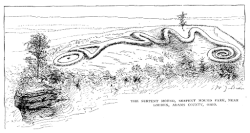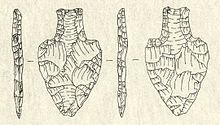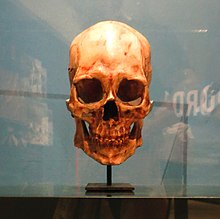
The archaeology of the Americas is the study of the archaeology of the Western Hemisphere, including North America (Mesoamerica), Central America, South America and the Caribbean. This includes the study of pre-historic/Pre-Columbian and historic indigenous American peoples, as well as historical archaeology of more recent eras, including the Trans-Atlantic slave trade and European colonization.

In the History of Mesoamerica, the stage known as the Paleo-Indian period is the era in the scheme of Mesoamerican chronology which begins with the very first indications of human habitation within the Mesoamerican region, and continues until the general onset of the development of agriculture and other proto-civilisation traits. The conclusion of this stage may be assigned to approximately 9000 BP, and the transition to the succeeding Archaic period is not a well-defined one.

Clovis points are the characteristically fluted projectile points associated with the New World Clovis culture, a prehistoric Paleo-American culture. They are present in dense concentrations across much of North America and they are largely restricted to the north of South America. There are slight differences in points found in the Eastern United States bringing them to sometimes be called "Clovis-like". Clovis points date to the Early Paleoindian period, with all known points dating from roughly 13,400–12,700 years ago. As an example, Clovis remains at the Murry Springs Site date to around 12,900 calendar years ago. Clovis fluted points are named after the city of Clovis, New Mexico, where examples were first found in 1929 by Ridgely Whiteman.

In the classification of the archaeological cultures of North America, the Archaic period in North America, taken to last from around 8000 to 1000 BC in the sequence of North American pre-Columbian cultural stages, is a period defined by the archaic stage of cultural development. The Archaic stage is characterized by subsistence economies supported through the exploitation of nuts, seeds, and shellfish. As its ending is defined by the adoption of sedentary farming, this date can vary significantly across the Americas.

Paleo-Indians were the first peoples who entered and subsequently inhabited the Americas during the final glacial episodes of the late Pleistocene period. The prefix paleo- comes from the Ancient Greek adjective: παλαιός, romanized: palaiós, lit. 'old; ancient'. The term Paleo-Indians applies specifically to the lithic period in the Western Hemisphere and is distinct from the term Paleolithic.

The Folsom tradition is a Paleo-Indian archaeological culture that occupied much of central North America from c. 10800 BCE to c. 10200 BCE. The term was first used in 1927 by Jesse Dade Figgins, director of the Denver Museum of Nature and Science. The discovery by archaeologists of projectile points in association with the bones of extinct Bison antiquus, especially at the Folsom site near Folsom, New Mexico, established much greater antiquity for human residence in the Americas than the previous scholarly opinion that humans in the Americas dated back only 3,000 years. The findings at the Folsom site have been called the "discovery that changed American archaeology."

The Plano cultures is a name given by archaeologists to a group of disparate hunter-gatherer communities that occupied the Great Plains area of North America during the Paleo-Indian or Archaic period.
The Paleo-Arctic Tradition is the name given by archaeologists to the cultural tradition of the earliest well-documented human occupants of the North American Arctic, which date from the period 8000–5000 BC. The tradition covers Alaska and expands far into the east, west, and the Southwest Yukon Territory.

Several chronologies in the archaeology of the Americas include a Formative Period or Formative stage etc. It is often sub-divided, for example into "Early", "Middle" and "Late" stages.
Southwestern archaeology is a branch of archaeology concerned with the Southwestern United States and Northwestern Mexico. This region was first occupied by hunter-gatherers, and thousands of years later by advanced civilizations, such as the Ancestral Puebloans, the Hohokam, and the Mogollon.

The Thunderbird Archaeological District, near Limeton, Virginia, is an archaeological district described as consisting of "three sites—Thunderbird Site, the Fifty Site, and the Fifty Bog—which provide a stratified cultural sequence spanning Paleo-Indian cultures through the end of Early Archaic times with scattered evidence of later occupation."
J&J Hunt Site (8JE740) is an inundated prehistoric archaeological site located 6 km off the coast of northwestern Florida. The site which was discovered in 1989 is located in 3.7 to 4.6 m of salt water in the Gulf of Mexico along the PaleoAucilla River. In prehistory the site had at least two different occupations: a Late Paleoindian-Early Archaic and Middle Archaic. The J&J Hunt site was a major focus of the PaleoAucilla Prehistory Project conducted by Michael K. Faught.

The Jones-Miller Bison Kill Site, located in northeast Colorado, was a Paleo-Indian site where Bison antiquus were killed using a game drive system and butchered. Hell Gap complex bones and tools artifacts at the site are carbon dated from about ca. 8000-8050 BC.

The Archaic–Early Basketmaker Era was an Archaic cultural period of ancestors to the Ancient Pueblo People. They were distinguished from other Archaic people of the Southwest by their basketry which was used to gather and store food. They became reliant on wild seeds, grasses, nuts, and fruit for food and changed their movement patterns and lifestyle by maximizing the edible wild food and small game within a geographical region. Manos and metates began to be used to process seeds and nuts. With the extinction of megafauna, hunters adapted their tools, using spears with smaller projectile points and then atlatl and darts. Simple dwellings made of wood, brush and earth provided shelter.

The following outline is provided as an overview of and topical guide to the prehistoric people of Colorado, which covers the period of when Native Americans lived in Colorado prior to contact with the Domínguez–Escalante expedition in 1776. People's lifestyles included nomadic hunter-gathering, semi-permanent village dwelling, and residing in pueblos.
Prehistoric technology is technology that predates recorded history. History is the study of the past using written records. Anything prior to the first written accounts of history is prehistoric, including earlier technologies. About 2.5 million years before writing was developed, technology began with the earliest hominids who used stone tools, which they first used to hunt food, and later to cook.
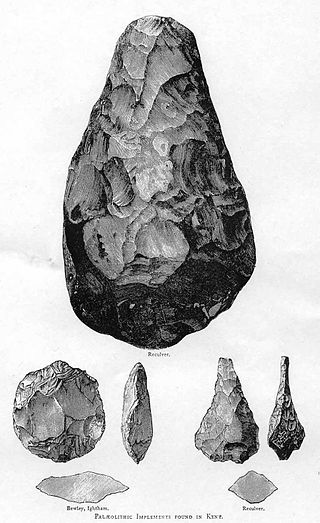
The following outline is provided as an overview of and topical guide to prehistoric technology.
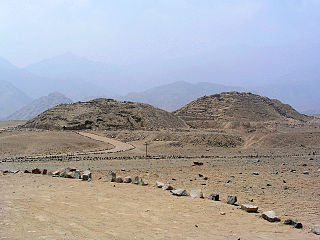
The Andean preceramic refers to the early period of human occupation in the Andean area of South America that preceded the introduction of ceramics. This period is also called pre-ceramic or aceramic.

Several chronologies in the archaeology of the Americas include an Archaic Period or Archaic stage etc. It is often sub-divided, for example into "Early", "Middle" and "Late", or alternatively "Lower" and "Upper", stages. The dates, and the characteristics of the period called "Archaic" vary between different parts of the Americas. Sometimes also referred to as the "Pre-Ceramic stage" or period, it followed the Lithic stage and was superseded by the Formative stage, or a Preformative stage. The typical broad use of the terms is as follows:
